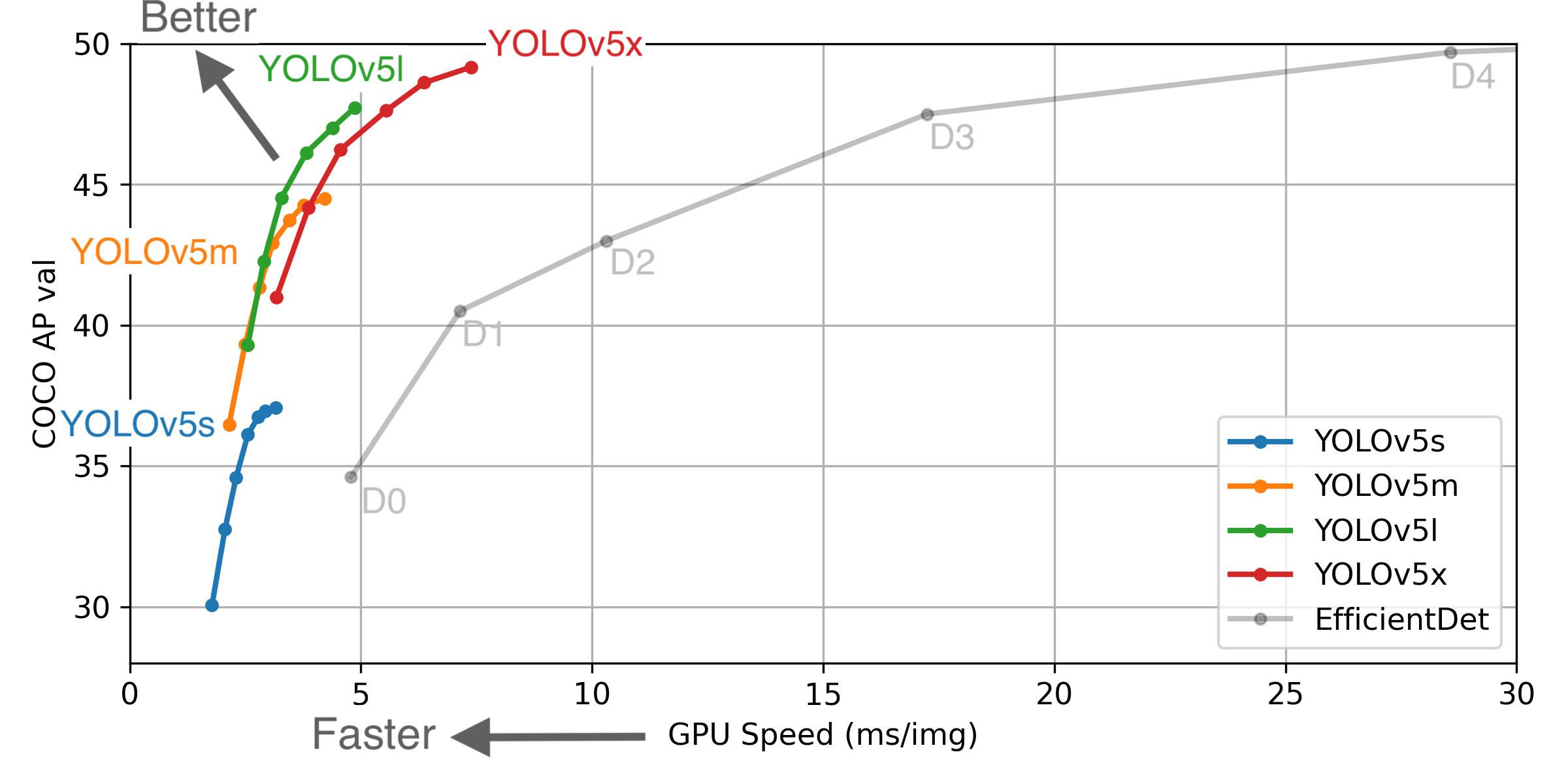Comments (7)
Ah yes. I did not comment this area sufficiently, I will do a commit to better explain this. This section assigns the closest grid point gi, gj, and anchor a to each target, to ensure that each grid-anchor point is only assigned to one target.
My first technique to do this was to select unique rows from the n x 3 [gi, gj, a] matrix using:
u = torch.cat((gi, gj, a), 0).view(3, -1).numpy()
_, first_unique_slow = np.unique(u[:, iou_order], axis=1, return_index=True) # first unique indicesbut during profiling I found np.unique was slow in selecting unique rows, so I merged the 3 columns into a single column by the dot product of a random 1 x 3 vector (the 3 random constants you see here). This produced much faster np.unique results.
u = gi.float() * 0.4361538773074043 + gj.float() * 0.28012496588736746 + a.float() * 0.6627147212460307
_, first_unique = np.unique(u[iou_order], return_index=True) # first unique indicesI tested the two methods for accuracy using this line, and found differences extremely rare... but wait these are both sorted, and the output used later on is not sorted. Ok I will look into this some more to see the effect of the sorting.
print(((np.sort(first_unique_slow) - np.sort(first_unique)) ** 2).sum())from yolov3.
Yes I've confirmed there is is a bug here. Thank you very much for spotting this! So numpy returns sorted unique indices by default, whereas I assumed they retained the original order. There exists an open numpy issue on the topic:
numpy/numpy#8621
I've corrected this by reverting to the unique row method (first example above), which does appear to retain the original order. Commit is 6116acb.
from yolov3.
Thank you.
from yolov3.
@glenn-jocher Could you please explain how this will affect results because it seems like results will be the same whichever method we use.
from yolov3.
@Bilal-Yousaf Ultralytics has open-sourced YOLOv5 at https://github.com/ultralytics/yolov5, featuring faster, lighter and more accurate object detection. YOLOv5 is recommended for all new projects.

** GPU Speed measures end-to-end time per image averaged over 5000 COCO val2017 images using a V100 GPU with batch size 32, and includes image preprocessing, PyTorch FP16 inference, postprocessing and NMS. EfficientDet data from [google/automl](https://github.com/google/automl) at batch size 8.
- August 13, 2020: v3.0 release: nn.Hardswish() activations, data autodownload, native AMP.
- July 23, 2020: v2.0 release: improved model definition, training and mAP.
- June 22, 2020: PANet updates: new heads, reduced parameters, improved speed and mAP 364fcfd.
- June 19, 2020: FP16 as new default for smaller checkpoints and faster inference d4c6674.
- June 9, 2020: CSP updates: improved speed, size, and accuracy (credit to @WongKinYiu for CSP).
- May 27, 2020: Public release. YOLOv5 models are SOTA among all known YOLO implementations.
- April 1, 2020: Start development of future compound-scaled YOLOv3/YOLOv4-based PyTorch models.
Pretrained Checkpoints
| Model | APval | APtest | AP50 | SpeedGPU | FPSGPU | params | FLOPS | |
|---|---|---|---|---|---|---|---|---|
| YOLOv5s | 37.0 | 37.0 | 56.2 | 2.4ms | 416 | 7.5M | 13.2B | |
| YOLOv5m | 44.3 | 44.3 | 63.2 | 3.4ms | 294 | 21.8M | 39.4B | |
| YOLOv5l | 47.7 | 47.7 | 66.5 | 4.4ms | 227 | 47.8M | 88.1B | |
| YOLOv5x | 49.2 | 49.2 | 67.7 | 6.9ms | 145 | 89.0M | 166.4B | |
| YOLOv5x + TTA | 50.8 | 50.8 | 68.9 | 25.5ms | 39 | 89.0M | 354.3B | |
| YOLOv3-SPP | 45.6 | 45.5 | 65.2 | 4.5ms | 222 | 63.0M | 118.0B |
** APtest denotes COCO test-dev2017 server results, all other AP results in the table denote val2017 accuracy.
** All AP numbers are for single-model single-scale without ensemble or test-time augmentation. Reproduce by python test.py --data coco.yaml --img 640 --conf 0.001
** SpeedGPU measures end-to-end time per image averaged over 5000 COCO val2017 images using a GCP n1-standard-16 instance with one V100 GPU, and includes image preprocessing, PyTorch FP16 image inference at --batch-size 32 --img-size 640, postprocessing and NMS. Average NMS time included in this chart is 1-2ms/img. Reproduce by python test.py --data coco.yaml --img 640 --conf 0.1
** All checkpoints are trained to 300 epochs with default settings and hyperparameters (no autoaugmentation).
** Test Time Augmentation (TTA) runs at 3 image sizes. Reproduce by python test.py --data coco.yaml --img 832 --augment
For more information and to get started with YOLOv5 please visit https://github.com/ultralytics/yolov5. Thank you!
from yolov3.
@glenn-jocher Could you please explain how this will affect results because it seems like results will be the same whichever method we use.
Thank You for sharing YoloV5.
Could you please point out how np.unique returning sorted output will affect results? I think this is handled properly?
from yolov3.
@Bilal-Yousaf the use of np.unique with sorted output would not affect the results in this specific scenario, as it is handled properly in the existing code. Both methods would yield the same results in this implementation. Thank you for bringing this up, and feel free to reach out if you have any more questions or concerns!
from yolov3.
Related Issues (20)
- About the instructions and code comments HOT 3
- A hopelessly long try to replicate the YOLOv3 kernel HOT 2
- Change in the anchor boxes HOT 10
- ❗️Closed per Code of Conduct HOT 1
- no anchor_grid in V9.6.0 yolov3.pt HOT 5
- Convert YOLOv3 dataset format to YOLOv8 HOT 3
- What's the difference between it and Yolov3 by Joseph Redmon ? HOT 7
- Integrating YOLOv8 into YOLOv3 Ultralytics HOT 2
- Seeking Advice on Equivalent YOLOv5 Variant to Standard YOLOv3 HOT 1
- Unexpectedly large trained model size (~200 MB .pt and ~400 MB .onnx) HOT 4
- Training requires much more VRAM than v5/v8 and results in ~200 MB models comparing to <15 MB models of v5/v8 HOT 5
- how to train your yolov8?
- Need info regarding yolov3-tiny anchors, dataset creation and loss function. HOT 5
- Cannot compute loss function from best model HOT 1
- yolov3_ros input topic channel problem HOT 5
- Issue with training YOLOv3-tiny from scratch HOT 4
- yolov3.pt HOT 4
- 关于调用推理代码块遇到的与一些问题 HOT 8
- Bug of incomplete information display HOT 2
- No module named 'ultralytics.yolo' HOT 2
Recommend Projects
-
 React
React
A declarative, efficient, and flexible JavaScript library for building user interfaces.
-
Vue.js
🖖 Vue.js is a progressive, incrementally-adoptable JavaScript framework for building UI on the web.
-
 Typescript
Typescript
TypeScript is a superset of JavaScript that compiles to clean JavaScript output.
-
TensorFlow
An Open Source Machine Learning Framework for Everyone
-
Django
The Web framework for perfectionists with deadlines.
-
Laravel
A PHP framework for web artisans
-
D3
Bring data to life with SVG, Canvas and HTML. 📊📈🎉
-
Recommend Topics
-
javascript
JavaScript (JS) is a lightweight interpreted programming language with first-class functions.
-
web
Some thing interesting about web. New door for the world.
-
server
A server is a program made to process requests and deliver data to clients.
-
Machine learning
Machine learning is a way of modeling and interpreting data that allows a piece of software to respond intelligently.
-
Visualization
Some thing interesting about visualization, use data art
-
Game
Some thing interesting about game, make everyone happy.
Recommend Org
-
Facebook
We are working to build community through open source technology. NB: members must have two-factor auth.
-
Microsoft
Open source projects and samples from Microsoft.
-
Google
Google ❤️ Open Source for everyone.
-
Alibaba
Alibaba Open Source for everyone
-
D3
Data-Driven Documents codes.
-
Tencent
China tencent open source team.


from yolov3.